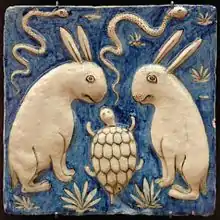Zakariya al-Qazwini
Abu Yahya Zakariya' ibn Muhammad al-Qazwini (أبو یحیی زکریاء بن محمد القزویني) or Zakarya Qazvini (Persian: زکریا قزوینی) (1203–1283) was a Persian physician, astronomer, geographer and writer of Arab origin.[1][2][3][4] He belonged to a family of jurists who had long before settled in Qazvin. Some religious scholars state his family was originally of Arab and descended from the Medinian Sahabi (Companion of the Prophet Muhammad) Anas bin Malik,[5] but that has never been proven.


Career
Born in Qazvin, Iran, Zakariya Qazvini served as a legal expert and judge in several localities in Iran and at the city of Baghdad. He travelled around in Mesopotamia and the Levant, and finally entered the circle patronized by the governor of Baghdad, Ata-Malik Juvayni (d. 1283 CE).
It was to the latter that Qazvini dedicated his famous cosmography titled "The Wonders of Creation" (عجائب المخلوقات وغرائب الموجودات, Marvels of Creatures and Strange Things Existing). This treatise, frequently illustrated, was immensely popular and is preserved today in many copies. It was translated into his native Persian language, and later also into Turkish.
Qazvini was also well known for his geographical dictionary "Monument of Places and History of God's Bondsmen" (آثار البلاد وأخبار العباد). Both of these treatises reflect extensive reading and learning in a wide range of disciplines.
Qazvini mentioned how alchemists dubbed "swindlers" claimed to have carried out the transmutation of metals into gold; he states:
…they ruined the development of the science of chemistry, by fooling powerful rulers such as Imad ad-Din Zengi and thus many scholars and various colleagues turned against alchemy thus resulting in the isolation of the science.[6]
See also
- List of Persian scientists and scholars
References
- Black, Jeremy (2014-01-14). The Power of Knowledge: How Information and Technology Made the Modern World. Yale University Press. p. 40. ISBN 978-0-300-19854-6.
Al Qazwini a Persian of Arab ancestry.
- ĀṮĀR AL-BELĀD, C. E. Bosworth, Encyclopaedia Iranica; "Ātar Al-Belad: the title of a geographical work composed in Arabic during the 7th/13th century by the Persian scholar Abū Yaḥyā Zakarīyāʾ b. Moḥammad Qazvīnī". iranicaonline.org
- Iranian Entomology: An Introduction, Volume I, ed. Cyrus Abivardi, (Springer, 2001), 495.
- Bernard Lewis, A Middle East Mosaic: Fragments of Life, Letters and History, (Random House, 2000), 439.
- Bosworth, C.E. (1990). The encyclopaedia of Islam, Vol IV (2. impression. ed.). Leiden [u.a.]: Brill. p. 865. ISBN 9004057455.
He drew his origin from an Arab family (his ancestor, Shaykh Abu 'l-Kasim b. Hibat Allah al-Kazwini, was probably descended from Anas b. Malik [q.v.]), who had been Persianised after settling at Kazwin in Persia.
- Houtsma, Martijn Theodoor (1993). E. J. Brill's First Encyclopaedia of Islam, 1913-1936. BRILL. ISBN 90-04-09790-2.
Sources
- T. Lewicki, 'Kazwini' in The Encyclopaedia of Islam, 2nd edition, ed. by H.A.R. Gibbs, B. Lewis, Ch. Pellat, C. Bosworth et al., 11 vols. (Leiden: E.J. Brill, 1960–2002), vol. 4, pp 865–7
- L. Richter-Bernburg, 'al-Qazwini, Zakariyya' ibn Muhammad', in Encyclopedia of Arabic Literature, ed. by Julie Scott Meisami and Paul Starkey (London: Routledge, 1998), vol. 2, pp 637–8.
- Persis Berlekamp, Wonder, Image, and Cosmos in Medieval Islam (New Haven/London: Yale University Press, 2011).
- Islamic Medical Manuscripts at the National Library of Medicine. U.S. National Library of Medicine, Bethesda, MD.
- His cosmography was edited by F. Wüstenfeld, ‘Aja'ib al-makhluqat (Göttingen, 1849) – a partial German translation was published by A. Giese, Al-Qazwini, Die Wunder des Himmels und der Erde (Stuttgart and Vienna, 1986).
- Zakarija ben Muhammed ben Mahmud el-Cazwini's: Kosmographie .. (1848) Volume: 1
- His geographical dictionary was edited by Wüstenfeld as Athar al-bilad (Göttingen, 1848).
External links
| Wikimedia Commons has media related to Zakariya al-Qazwini. |
- Ahmad, S. Maqbul (2008) [1970-80]. "Al-Qazwīnī, Zakariyā Ibn Muḥammad Ibn Maḥmūd, Abū Yaḥyā". Complete Dictionary of Scientific Biography. Encyclopedia.com.
- Turning the Pages Several pages from Al-Qazwini's Kitab Aja’ib al-makhluqat wa Gharaib al-Mawjudat, known as “The Cosmography” or “The Wonders of Creation.”
- Kitāb al-ʻajāʾib wa al-gharāʼib. Full online version from the Getty Library.